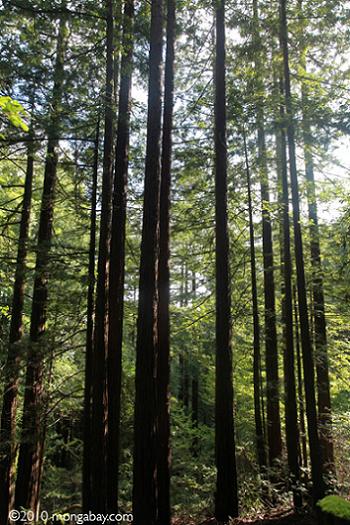Decline in fog threatens California's redwoods

A surprising new study finds that during the past century the
frequency of fog along California's coast has declined by approximately
three hours a day. Published in the Proceedings of the National Academy
of Sciences the researchers are concerned that this decrease in fog
threatens California's giant redwoods and the unique ecosystem they
inhabit.
"As fog decreases, the mature redwoods along the coast are not likely to die outright, but there may be less recruitment of new trees; they will look elsewhere for water, high humidity and cooler temperatures," explains coauthor Todd E. Dawson, professor of integrative biology and University of California, Berkeley professor of integrative biology with the Department of Environmental Science, Policy and Management (ESPM).
"What does that mean for the current redwood range and that of the
plants and animals with them?" he adds.
Evaluating data from airports along the northern California coast,
researchers were able to find a steady link in the occurrence of coastal
fog and large temperature differences between coast and inland areas.
Then by examining temperature data from 114 stations up and down the
Pacific Coast, the researchers found that the temperature contrasts
between coast and inland areas had shrunk over the past century leading
to a decline in fog.
"Since 1901, the average number of hours of fog along the coast in
summer has dropped from 56 percent to 42 percent," explains study leader
James A. Johnstone, a postdoctoral scholar at UC Berkeley's Department
of Environmental Science, Policy and Management (ESPM). "A cool coast
and warm interior is one of the defining characteristics of California's
coastal climate, but the temperature difference between the coast and
interior has declined substantially in the last century, in step with
the decline in summer fog."
This drop in fog occurrence along with the change in temperature
contrasts means that "coast redwood and other ecosystems along the U.S.
West Coast may be increasingly drought-stressed, with a summer climate
of reduced fog frequency and greater evaporative demand," adds Dawson.
"Fog prevents water loss from redwoods in summer, and is really
important for both the tree and the forest. If the fog is gone, we might
not have the redwood forests we do now."
Johnstone and his colleagues are uncertain whether the temperature
changes, and thereby the decline in fog, is apart of a natural cycle or
linked to human impacts such as climate change. But in order to find the
answer they plan to next look at redwood tree ring data and stable
isotopes from redwood cellulose to construct the past climate of the
coast.
"Redwoods live for more than 2,000 years, so they could be a very
important indicator of climate patterns and change along the coast,"
Dawson says.
Only 5 percent of primary growth redwood forests survive today; the rest
has been logged or developed. According to
Save the Redwoods
League, eighteen percent of the remaining coastal redwood forests
are protected, the rest lies either on private land or in natural
forests, which could be logged in the future. Save the Redwoods League,
along with Berkeley Atmospheric Sciences, funded the study.
Citation: James Johnstone and Todd Dawson. Context and ecological
implications of summer fog decline in the coast redwood region. PNAS.
doi/10.1073/pnas.0915062107.